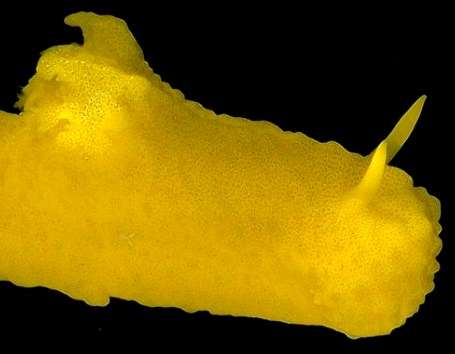Camouflage in Notodoris citrina
February 5, 2000
From: Bill Rudman

While preparing the Notodoris citrina page I came across this photo which shows its remarkable skin texture which is almost identical to the structure of the calcareous sponge Leucetta on which it feeds. To further camouflage the animal, species of Notodoris have flaps of skin which arch over the gills, hiding them from being seen from above.
In my experience, one behavioural difference between N. citrina and the other well-known yellow species (Notodoris gardineri, Notodoris minor) is that whereas those latter two are almost always nestled on their food sponge (Pericharax), N. citrina is often found on the substrate, crawling between the smaller colonies of its food sponge. In these instances, as I have suggested for the red Rostanga arbuta, looking like the food sponge means that you are well hidden when you are on the sponge, and have the potential to be mistaken for a sponge colony, when off it.
If you look carefully at the photo, halfway down the body and just anterior to the gills, you will see a yellow commensal copepod with its pair of egg sacs. Another example of camouflage.
The photo was taken by me in Nouméa, New Caledonia, 15 October 1988. 35mm long alive.
Bill Rudman.
Related messages
-
Notodoris citrina from sthn Queensland
From: Gary Cobb, October 1, 2009 -
Notodoris citrina from Indonesia
From: Mike Oelrich, February 17, 2005 -
Notodoris citrina from Lord Howe Island
From: W.B. Rudman, January 28, 2003 -
Ontogenetic colour change in Notodoris
From: Richard Willan, November 29, 2002 -
Notodoris citrina from Queensland
From: Carle Parkhill, August 7, 2001 -
Notodoris citrina? from the Marshall Ids
From: Scott Johnson, February 7, 2000 -
Notodoris citrina from Papua New Guinea
From: Mary Jane Adams, February 5, 2000
